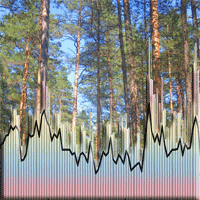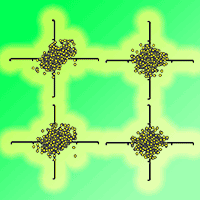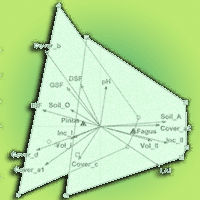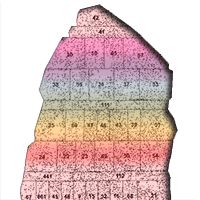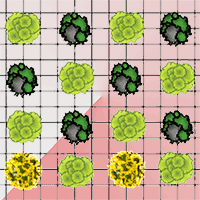Forest site (FS) and meteorological conditions are recognized as the main factors affecting tree growth and whole-stand sustainability. This study aims to detect the combined effects of FS and meteorological conditions on tree ring formation of Scots pine (Pinus sylvestris L.), the most common tree species in Lithuania and hemi-boreal forests of northeastern Europe. We used data on stand structure and productivity from the Lithuanian National Forest Inventory (NFI) and stem radial increment series of dominating trees during the period 1993-2012 collected since 2013. Pine stem basal area increment (BAI) was chosen as the response variable, while temperature in March (°C) and precipitation in June (mm) were used as predictor variables, as they best express the effect of climate change on Lithuanian forests. We simulated the effects on dominating pine annual increment of deciduous tree species, mainly Betula sp. and the level of soil moisture and fertility, accounting in addition for the random effects of NFI network tract, plot direction, and tree number. A nonlinear mixed-effects model explained up to 68% of the variation in the BAI of pine trees. The annual pine trees BAI increased with the increase in the proportion of deciduous trees in pine stands. Increases in temperature and precipitation in considered months reinforced this positive effect on pine BAI, especially in mature pine stands in temporarily waterlogged meso-eutrophic FSs on mineral soils. A negative effect of deciduous trees on pine stem increment was observed only in nutrient-rich eutrophic and drained peatland FSs. Forestry treatments directed towards the increase in deciduous tree proportion in the most common normal or temporarily waterlogged meso-eutrophic and oligotrophic pine stands might increase the biodiversity and productivity of pine stands, and their sustainability in future climate change scenarios.
Keywords
, , , , ,
Citation
Mikalajunas M, Pretzsch H, Mozgeris G, Linkevičius E, Augustaitiene I, Augustaitis A (2021). Scots pine’s capacity to adapt to climate change in hemi-boreal forests in relation to dominating tree increment and site condition. iForest 14: 473-482. - doi: 10.3832/ifor3703-014
Academic Editor
Gianluca Piovesan
Paper history
Received: Nov 20, 2020
Accepted: Aug 17, 2021
First online: Oct 18, 2021
Publication Date: Oct 31, 2021
Publication Time: 2.07 months
© SISEF - The Italian Society of Silviculture and Forest Ecology 2021
Open Access
This article is distributed under the terms of the Creative Commons Attribution-Non Commercial 4.0 International (https://creativecommons.org/licenses/by-nc/4.0/), which permits unrestricted use, distribution, and reproduction in any medium, provided you give appropriate credit to the original author(s) and the source, provide a link to the Creative Commons license, and indicate if changes were made.

Breakdown by View Type
(Waiting for server response...)
Article Usage
Total Article Views: 32645
(from publication date up to now)
Breakdown by View Type
HTML Page Views: 27564
Abstract Page Views: 2688
PDF Downloads: 1814
Citation/Reference Downloads: 4
XML Downloads: 575
Web Metrics
Days since publication: 1505
Overall contacts: 32645
Avg. contacts per week: 151.84
Article Citations
Article citations are based on data periodically collected from the Clarivate Web of Science web site
(last update: Mar 2025)
Total number of cites (since 2021): 4
Average cites per year: 0.80
Publication Metrics
by Dimensions ©
Articles citing this article
List of the papers citing this article based on CrossRef Cited-by.
(1)
Aldea J, Ruiz-Peinado R, Del Río M, Pretzsch H, Heym M, Brazaitis G, Jansons A, Metslaid M, Barbeito I, Bielak K, Granhus A, Holm SO, Nothdurft A, Sitko R, Lof M (2021)Species stratification and weather conditions drive tree growth in Scots pine and Norway spruce mixed stands along Europe. Forest Ecology and Management 481: 118697.
CrossRef |
Gscholar
(2)
Augustaitis A (2007a)Pine sawfly (
Diprion pini L.) - Related changes in Scots pine crown defoliation and possibilities of recovery. Polish Journal of Environmental Studies 16: 363-369.
Gscholar
(3)
Augustaitis A, Augustaitiene I, Cinga G, Mazeika J, Deltuvas R, Juknys R, Vitas A (2007b)Did the ambient ozone affect stem increment of Scots pines (
Pinus sylvestris L.) on territories under regionnal pollution load? Step III of Lithuanian studies. Scientific World Journal 7: 58-66.
CrossRef |
Gscholar
(4)
Augustaitis A, Augustaitiene I, Mozgeris G, Juknys R, Vitas A, Jasinevičiene D (2015)Growth patterns of scots pine (
Pinus sylvestris L.) under the current regional pollution load in Lithuania. iForest 8: 509-516.
CrossRef |
Gscholar
(5)
Augustaitis A, Augustaitiene I, Baumgarten M, Bicenkiene S, Girgdiene R, Kulbokas G, Linkevičius E, Marozas V, Mikalajunas M, Mordas G, Mozgeris G, Petrauskas E, Pivoras A, Ulevičius V, Vitas A, Matyssek R (2018)Tree-ring formation as an indicator of forest capacity to adapt to the main threats of environmental changes in Lithuania. Science of the Total Environment 615: 1247-1261.
CrossRef |
Gscholar
(6)
Baillie MGL, Pilcher JR (1973)A simple cross-dating program for tree-ring research. Tree-Ring Bulletin 33: 7-14.
Gscholar
(7)
Biondi F, Qeadan F (2008)A theory-driven approach to tree-ring standardization: defining the biological trend from expected basal area increment. Tree Ring Research 64 (2): 81-96.
CrossRef |
Gscholar
(8)
Bouwman M, Forrester DI, Den Ouden J, Nabuurs GJ, Mohren GMJ (2021)Species interactions under climate change in mixed stands of Scots pine and pedunculate oak. Forest Ecology and Management 481: 118615.
CrossRef |
Gscholar
(9)
Burnham KP, Anderson DR (2002)Model Selection and Inference: a practical information-theoretic approach (2nd edn). Springer-Verlag, New York, USA, pp. 488.
CrossRef |
Gscholar
(10)
Chapagain TR, Sharma RP (2021)Modeling form factors for sal (
Shorea robusta Gaertn.) using tree and stand measures, and random effects. Forest Ecology and Management 482: 118807.
CrossRef |
Gscholar
(11)
Cook ER, Kairiukstis LA (1990)Methods of dendrochronology - Applications in the environmental sciences. Springer, Dordrecht, Netherlands, pp. 97-162.
CrossRef |
Gscholar
(12)
Daly C, Gibson WP, Taylor GH, Johson GL, Pasteris P (2002)A knowledge-based approach to the statistical mapping of climate. Climate Research 22: 99-113.
CrossRef |
Gscholar
(13)
De Vries W, Dobbertin MH, Solberg S, Van Dobben HF, Schaub M (2014)Impacts of acid deposition, ozone exposure and weather conditions on forest ecosystems in Europe: an overview. Plant and Soil 380: 1-45.
CrossRef |
Gscholar
(14)
Eckstein D, Krause C, Bauch J (1989)Dendroecological investigation of spruce trees (
Picea abies (L.) Karst.) of different damage and canopy classes. Holzforschung 43: 411-417.
CrossRef |
Gscholar
(15)
Forrester DI, Albrecht AT (2014)Light absorption and light-use efficiency in mixtures of
Abies alba and
Picea abies along a productivity gradient. Forest Ecology and Management 328: 94-102.
CrossRef |
Gscholar
(16)
Fu L, Le X, Sharma RP, Li H, Zhu G, Hong L, You L, Duan G, Guo H, Lei Y, Li Y, Tang S (2018)Comparing height-age and height-diameter modelling approaches for estimating site productivity of natural uneven-aged forests. Forestry 91: 419-433.
CrossRef |
Gscholar
(17)
Garant MP, Huang JG, Izquierdo G, Raulier F, Bernier P, Berninger F (2009)Use of tree rings to study the effect of climate change on trembling aspen in Quebec. Global Change Biology 16: 2039-2051.
CrossRef |
Gscholar
(18)
García O (2005)Comparing and combining stem analysis and permanent sample plot data in site index models. Forest Science 51: 277-283.
Online |
Gscholar
(19)
Girardin MP, Raulier F, Bernier PY, Tardif JC (2008)Response of tree growth to a changing climate in boreal central Canada: a comparison of empirical, process-based, and hybrid modelling approaches. Ecological Modelling 213: 209-228.
CrossRef |
Gscholar
(20)
Hökkä H, Groot A (2011)An individual-tree basal area growth model for black spruce in second-growth peatland stands. Canadian Journal of Forest Research 29: 621-629.
CrossRef |
Gscholar
(21)
IPCC (2014)Climate change 2014: synthesis report. In: “Contribution of Working Groups I, II and III to the Fifth Assessment Report” (Pachauri RK, Meyer LA eds). Intergovernmental Panel on Climate Change - IPCC, Geneva, Switzerland, pp. 151.
Gscholar
(22)
Jactel H, Gritti E, Drössler L, Forrester D, Mason W, Morin X, Pretzsch H, Castagneyrol B (2018)Positive biodiversity-productivity relationships in forests: climate matters. Biology Letters 14: 20170747.
CrossRef |
Gscholar
(23)
Jucker T, Avacariei D, Barnoaiea I, Duduman G, Bouriaud O, Coomes DA (2016)Climate modulates the effects of tree diversity on forest productivity. Journal of Ecology 104: 388-398.
CrossRef |
Gscholar
(24)
Juknys R, Stravinskiene V, Vencloviene J (2002)Tree-ring analysis for the assessment of anthropogenic changes and trends. Environmental Monitoring and Assessment 77: 81-97.
CrossRef |
Gscholar
(25)
Juknys R, Vencloviene J, Stravinskiene V, Augustaitis A, Bartkevičius E (2003)Scots pine (
Pinus sylvestris L.) growth and condition in a polluted environment: from decline to recovery. Environmental Pollution 125: 205-212.
CrossRef |
Gscholar
(26)
Juknys R, Augustaitis A, Vencloviene J, Kliučius A, Adomas V, Bartkevičius E, Jurkonis N (2014)Dynamic response of tree growth to changing environmental pollution. European Journal of Forest Research 133: 713-724.
CrossRef |
Gscholar
(27)
Kairiukstis L, Grigaliunas J, Skuodiene L, Stravinskiene V (1987)Physiological and dendrochronological indications of forest decline and their application for monitoring. In: “Forest Decline and Reproduction: Regional and Global Consequences” (Kairiukstis L, Nilsson S, Straszak A eds). IIASA, Luxemburg, pp. 151-169.
Gscholar
(28)
Kulbokas G, Jurevičiene V, Kuliesis A, Augustaitis A, Petrauskas E, Mikalajunas M, Vitas A, Mozgeris G (2019)Fluctuations in gross volume increment estimated by the Lithuanian National Forest Inventory compared with annual variations in single tree increment. Baltic Forestry 25: 273-280.
CrossRef |
Gscholar
(29)
Kuliešis A, Kasperavičius A, Kulbokas G (2016)Lithuania. In: “National Forest Inventories - Assessment of Wood Availability and Use” (Vidal C, Alberdi I, Hernandez L, Redmond J eds). Springer International Publishing, Cham, Switzerland, pp. 521-547.
CrossRef |
Gscholar
(30)
Lebourgeois F, Rathgeber CBK, Ulrich E (2010)Sensitivity of French temperate coniferous forests to climate variability and extreme events (
Abies alba, Picea abies and
Pinus sylvestris). Journal of Vegetation Science 21: 364 376.
CrossRef |
Gscholar
(31)
Liang J, Crowther TW, Picard N, Wiser S, Zhou M, Alberti G, Schulze ED, Mcguire AD, Bozzato F, Pretzsch H, de-Miguel S, Paquette A, Herault B, Scherer-Lorenzen M, Barrett CB, Glick HB, Hengeveld GM, Nabuurs GJ, Pfautsch S, Viana H, Vibrans AC, Ammer C, Schall P, Verbyla D, Tchebakova N, Fischer M, Watson JV, Chen HY, Lei X, Schelhaas MJ, Lu H, Gianelle D, Parfenova EI, Salas C, Lee E, Lee B, Kim HS, Bruelheide H, Coomes DA, Piotto D, Sunderland T, Schmid B, Gourlet-Fleury S, Sonke B, Tavani R, Zhu J, Brandl S, Vayreda J, Kitahara F, Searle EB, Neldner VJ, Ngugi MR, Baraloto C, Frizzera L, Ba azy R, Oleksyn J, Zawi a-Nied wiecki T, Bouriaud O, Bussotti F, Finer L, Jaroszewicz B, Jucker T, Valladares F, Jagodzinski AM, Peri PL, Gonmadje C, Marthy W, Obrien T, Martin EH, Marshall AR, Rovero F, Bitariho R, Niklaus PA, Alvarez-Loayza P, Chamuya N, Valencia R, Mortier F, Wortel V, Engone-Obiang NL, Ferreira LV, Odeke DE, Vasquez RM, Lewis SL, Reich PB (2016)Positive biodiversity-productivity relationship predominant in global forests. Science 354 (6309): aaf8957.
CrossRef |
Gscholar
(32)
Macias M, Andreu L, Bosch O, Camarero JJ, Gutiérrez E (2006)Increasing aridity is enhancing silver fir
Abies alba (Mill.) water stress in its south-western distribution limit. Climate Change 79: 289-313.
CrossRef |
Gscholar
(33)
Maestre FT, Cortina J (2004)Do positive interactions increase with abiotic stress? A test from a semi-arid steppe. Royal Society Biological sciences London B271: S331-S333.
CrossRef |
Gscholar
(34)
Matisons R, Elferts D, Krišans O, Schneck V, Gartner H, Bast A, Wojda T, Kowalczyk J, Jansons A (2021)Non-linear regional weather-growth relationships indicate limited adaptability of the eastern Baltic Scots pine. Forest Ecology and Management 479: 118600.
CrossRef |
Gscholar
(35)
McMillan AMS, Winston GC, Coulden ML (2008)Age-dependent response of boreal forest to temperature and rainfall variability. Global Change Biology 14 (8): 1904-1916.
CrossRef |
Gscholar
(36)
Mensah AA, Holmström E, Petersson H, Nyström K, Mason EG, Nilsson U (2021)The millennium shift: investigating the relationship between environment and growth trends of Norway spruce and Scots pine in northern Europe. Forest Ecology and Management 481: 118727.
CrossRef |
Gscholar
(37)
Michelot A, Breda N, Damesin C, Dufrene E (2012)Differing growth responses to climatic variations and soil water deficits of
Fagus sylvatica, Quercus petraea and
Pinus sylvestris in a temperate forest. Forest Ecology and Management 265: 161-171.
CrossRef |
Gscholar
(38)
Monserud RA, Sterba H (1996)A basal area increment model for individual trees growing in even- and uneven-aged forest stands in Austria. Forest Ecology and Management 80: 57-80.
CrossRef |
Gscholar
(39)
Nakagawa S, Schielzeth H (2013)A general and simple method for obtaining R
2 from generalized linear mixed-effects models. Methods in Ecology and Evolution 4: 133-142.
CrossRef |
Gscholar
(40)
Nellemann C, Thomsen M (2001)Long-term changes in forest growth: potential effects of nitrogen deposition and acidification. Water, Air, and Soil Pollution 128 (3/4): 197-205.
CrossRef |
Gscholar
(41)
Ols C, Kalas IH, Drobyshev I, Söderström L, Hofgaard A (2019)Spatiotemporal variation in the relationship between boreal forest productivity proxies and climate data. Dendrochronologia 58 (116): 125648.
CrossRef |
Gscholar
(42)
Pinheiro J, Bates D, Debroy S, Sarkar D (2018)nlme: linear and nonlinear mixed effects models. R Package Version 3:1-137.2018, web site.
Online |
Gscholar
(43)
Piovesan G, Biondi F, Filippo AD, Alessandrini A, Maugeri M (2008)Drought-driven growth reduction in old beech (
Fagus sylvatica L.) forests of the central Apennines, Italy. Global Change Biology 14: 1265-1281.
CrossRef |
Gscholar
(44)
Piutti E, Cescatti A (1997)A quantitative analysis of the interactions between climatic response and intraspecific competition in European beech. Canadian Journal of Forest Research 27: 277-284.
CrossRef |
Gscholar
(45)
Pretzsch H, Biber P, Dursky J (2002)The single tree-based stand simulator SILVA: construction, application and evaluation. Forest Ecology and Management 162: 3-21.
CrossRef |
Gscholar
(46)
Pretzsch H, Schütze G, Uhl E (2013)Resistance of european tree species to drought stress in mixed versus pure forests: evidence of stress release by inter-specific facilitation. Plant Biology 15: 483-495.
CrossRef |
Gscholar
(47)
Pretzsch H, Biber P, Schütze G, Uhl E, Rötzer T (2014)Forest stand growth dynamics in Central europe have accelerated since 1870. Nature Communications 5 (1): 1065.
CrossRef |
Gscholar
(48)
Pretzsch H, Rio M, Ammer C, Avdagic A, Barbeito I, Bielak K, Brazaitis G, Coll L, Dirnberger G, Drössler L (2015)Growth and yield of mixed versus pure stands of Scots pine (Pinus sylvestris L.) and european beech (Fagus sylvatica L.) along a gradient of productivity through europe. European Journal of Forest Research 134: 927-947.
CrossRef |
Gscholar
(49)
Pretzsch H (2020)The course of tree growth. Theory and reality. Forest Ecology and Management 478: 118508.
CrossRef |
Gscholar
(50)
R Development Core Team (2018)R: a language and environment for statistical computing. R Foundation for Statistical Computing, Vienna, Austria.
Online |
Gscholar
(51)
Ratcliffe S, Wirth C, Jucker T, Van Der Plas F, Scherer-Lorenzen M, Verheyen K, Allan E, Benavides R, Bruelheide H, Ohse B (2017)Biodiversity and ecosystem functioning relations in European forests depend on environmental context. Ecology Letters 20: 1414-1426.
CrossRef |
Gscholar
(52)
Reed DD, Jones EA, Tome M, Araujo MC (2003)Models of potential height and diameter for
Eucalyptus globulus in Portugal. Forest Ecology and Management 172: 191-198.
CrossRef |
Gscholar
(53)
Reich PB, Oleksyn J (2008)Climate warming will reduce growth and survival of Scots pine except in the far north. Ecology Letters 11 (6): 588-597.
CrossRef |
Gscholar
(54)
Rio M, Pretzsch H, Alberdi I, Bielak K, Bravo F, Brunner A, Condes S, Ducey M, Fonseca T, Lüpke N (2016)Characterization of the structure, dynamics, and productivity of mixed-species stands: review and perspectives. European Journal of Forest Research 135: 23-49.
CrossRef |
Gscholar
(55)
Rubio-Cuadrado A, Camarero JJ, Gomez C, Canellas I, Aullo-Maestro I, Gil L, Montes F (2020)Scots pine plantations growth adaptation to climate warming in locations at the southernmost distribution limit of the species. Dendrochronologia 63: 125745.
CrossRef |
Gscholar
(56)
Schlechtriem M (2019)Mapped: impact of climate on European countries. GREENMATCH, UK Blog Awards, UK, web site.
Online |
Gscholar
(57)
Schweingruber FH (1996)Tree rings and environment: dendroecology. Paul Haupt Publishers, Bern, Switzerland, pp. 609.
Online |
Gscholar
(58)
Seidling W, Ziche D, Beck W (2012)Climate responses and interrelations of stem increment and crown transparency in Norway spruce, Scots pine, and common beech. Forest Ecology and Management 284: 196-204.
CrossRef |
Gscholar
(59)
Sharma RP, Stefancik I, Vacek Z, Vacek S (2019)Generalized nonlinear mixed-effects individual tree diameter increment models for beech forests in Slovakia. Forests 10: 451-475.
CrossRef |
Gscholar
(60)
Skovsgaard JP, Vanclay JK (2008)Forest site productivity: a review of the evolution of dendrometric concepts for even-aged stands. Forestry 81: 12-31.
CrossRef |
Gscholar
(61)
Skrinskas S, Gasiuniene VE, Laurinavicius A, Podagelis I (2010)Lithuanian mineral resources, their reserves and possibilities for their usage in road building. The Baltic Journal of Road and Bridge Engineering 5 (4): 218-228.
CrossRef |
Gscholar
(62)
Spiecker H (1999)Overview of recent growth trends in European forests. Water, Air, and Soil Pollution 116 (1/2): 33-46.
CrossRef |
Gscholar
(63)
Sterba H, Del Rio M, Brunner A, Condes S (2014)effect of species proportion definition on the evaluation of growth in pure
vs. mixed stands. Forest Systems 23: 547-559.
CrossRef |
Gscholar
(64)
Toochi EC (2017)Forest and environment: developments in global change ecology. Forestry Research and Engineering 1 (3): 100-105.
Online |
Gscholar
(65)
Xu K, Wang X, Liang P, Wu Y, An H, Sun H, Wu P, Wu X, Li Q, Guo X, Wen X, Han W, Liu Ch Fan D (2019)A new tree-ring sampling method to estimate forest productivity and its temporal variation accurately in natural forests. Forest Ecology and Management 433: 219-227.
CrossRef |
Gscholar


